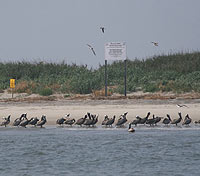
Bird Key Stono and Crab Bank, are closed to boat landings and the public from March 15 to Oct. 15 to protect nesting seabirds and Deveaux Bank is closed above the high tide line.
The South Carolina Budget & Control Board entered into agreements in 2006 with the S.C. Department of Natural Resources (DNR), enabling the DNR to designate and establish the three barrier islands as bird sanctuaries.
Trespassing violations on Bird Key Stono, Crab Bank, and Deveaux Bank incur a fine of up to $465 and/or 30 days in jail.
For additional information, contact Felicia Sanders (SandersF@dnr.sc.gov), wildlife biologist with DNR . Also check the DNR Managed Lands.
The nesting areas are managed by the DNR to help protect species such as brown pelicans, least terns, royal terns, sandwich terns, black skimmers, and great egrets. Crab Bank is a 16-acre island at the mouth of Shem Creek and Bird Key Stono is a 35-acre island at the Stono River Inlet. The area on these islands below the high water line is open to the public from Oct. 16 to March 14. Deveaux Bank, a 215-acre island between Seabrook and Edisto Islands, is closed year-round above the high water line. A portion of Deveaux Bank above the high water line is designated for limited recreational use. Dogs are prohibited on all of the islands year-round.
Although there are many barrier islands along the coast of South Carolina, only six have the correct profile for seabird usage. Species nesting on these estuarine islands typically find their location and mate in March, and build nests and lay eggs in April and May. Many younger birds do not leave nesting islands until October.
Seabirds often lay eggs in shallow scrapes or rough nests directly on the ground, and can easily be crushed underfoot. If approached, adult birds will leave the nest, and without shade, the sun quickly damages unprotected eggs, which are also easily snatched from their nests by gulls. Dogs are particularly damaging to colonies because of their instinct to chase the seabirds.
In South Carolina, brown pelican nesting has been declining for the last 15 years with the exception of slight increase last year. Pelicans completely abandoned Bird Key Stono in 2005 causing biologists to recommend, last year, additional protection of the seabird nesting islands. Other states are not experiencing significant population declines, and are, alternatively, recording population increases.
Dog and human footprints have been frequently recorded on South Carolina’s nesting areas, and these disturbances may also be causing a degradation of roosting habitat. After the new regulations took effect, few human and dog prints have been seen on the seabird nesting islands. Black skimmer nesting increased last year on the Seabird Sanctuaries. DNR is hopeful continued protection of the islands will cause other species to return and flourish.
In addition to the continuous management that takes place on the sanctuary islands in South Carolina, coordination of efforts between states that maintain monitoring programs for seabirds is an important step in their continued protection. A Southeast seabird workshop recently convened at the Marine Resources Center in Charleston, hosted by DNR wildlife biologists. The meeting allowed managers and researchers who work with monitoring seabirds and waterbirds in respective areas throughout the Southeast to collaborate, exchange ideas and coordinate efforts for the protection and conservation of populations throughout the region. Representatives from academic institutions, state agencies and organizations in Florida, Georgia, South Carolina, North Carolina and Virginia met to present findings of nesting summaries by associated state, as well as reflect on current research and monitoring designs in place for assessing seabird populations. Collaborators noted accomplishments in their research areas and made plans for establishing a long-range monitoring program and goals throughout the Southeast region.
For more information about DNR and how it manages and protects South Carolina’s natural resources, visit www.dnr.sc.gov.



Be the first to comment